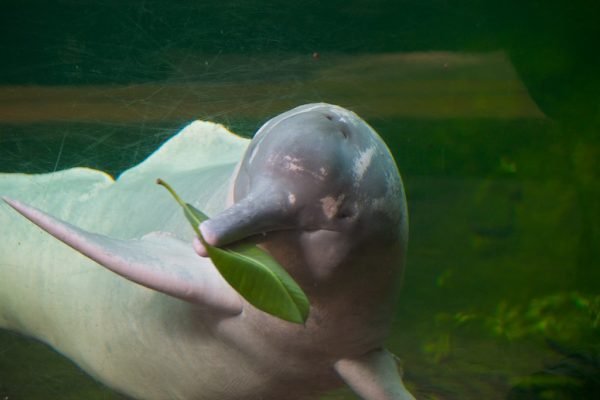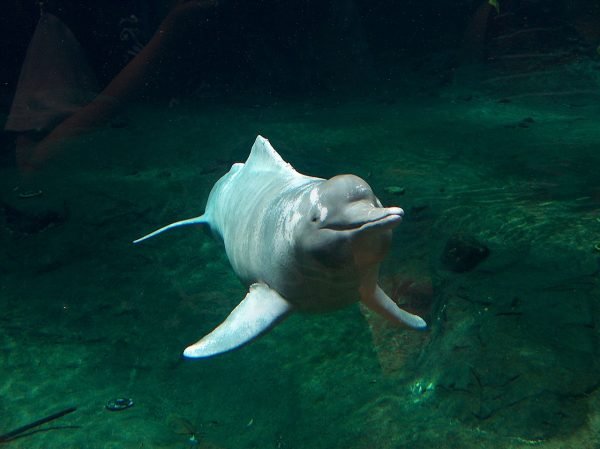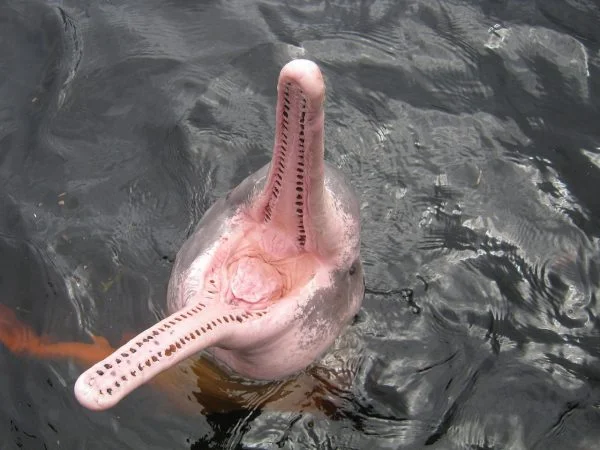Among all the dolphins in the world, the pink river dolphin is very unique not only in appearance but also in other physical characteristics. This dolphin has been very famous due to its pink color and usually, people doubt the existence of a pink-colored dolphin. We have gathered a complete set of Pink River Dolphin Facts that will not only give you a brief introduction to this amazing marine mammal but also let you learn about its adaptations and the threats it is facing. Enjoy these amazing Amazon River Dolphin Facts and do share them with your friends and family.
Pink River Dolphin Facts – Amazon River Dolphin Facts
1. What is Pink Dolphin
- The Pink River Dolphin is a species of dolphin that is found in the freshwater of the Amazon River in the Amazon Rainforest.
- It is the largest among all the river dolphin species and has certain unique adaptations which make them different from the other river dolphin species.

2. What are Pink Dolphins Called
Pink dolphins are also called:
- Boto
- Amazon River Dolphin
- Pink Dolphins
- Pink River Dolphins
- Amazon Dolphin
- Bufeo
3. Is a Pink River Dolphin a Mammal
- Yes, a pink river dolphin, like all other dolphins is a mammal that belongs to the subgroup of marine mammals. They do give birth to babies and unlike fish have lungs to breathe air.
4. Amazon River Dolphin Scientific Name
- The scientific name of the amazon river dolphin is Inia geoffrensis.
5. Pink River Dolphin Classification
| Kingdom: | Animalia |
| Phylum: | Chordata |
| Class: | Mammalia |
| Order: | Artiodactyla |
| Infraorder: | Cetacea |
| Family: | Iniidae |
| Genus: | Inia |
| Species: | I. geoffrensis |
6. Why are Pink Dolphins Pink
- Not all of the Pink river dolphins are pink. Mostly the young ones are grey and they get pink as they age. The adult male is pinker than the females.
- Several hypotheses exist for their pink color which are:
- This color is due to the blood vessels beneath their thin skins.
- Their scar tissue is pink in color and they fight a lot with each other thus they develop a pink color over time.
- The pink color also matches the red mud that occurs when the river flows in heavy rains.
- Some pink river dolphins are pink underneath and grey on the like other dolphins which are dark-colored on the back and light-colored underneath. This helps them in hiding from predators.

7. Are Pink Dolphins Real – Is there such thing as a Pink Dolphin
- Yes, Pink Dolphins are real and are found in the waterways of the Orinoco and Amazon rivers in South America.
8. Are Pink Dolphins Extinct
- No amazon pink river dolphins are not extinct. They are classified as “Endangered to vulnerable”. The estimated population is in the tens of thousands.
9. Amazon River Dolphin Lifespan
- The lifespan in the wild is unknown.
- The lifespan in captivity ranges from 10 to 30 years.
10. Amazon River Dolphin Size
- When compared to the sea dolphins, amazon river dolphins are a little smaller.
- Their average length ranges from 6 to 8 feet. An adult male can reach up to 8.2 feet (2.5 meters)
- Their average weight is between 185 and 355 pounds. An adult male can reach up to 508 pounds (185 kilograms).

11. What do Pink Dolphins Eat – Amazon River Dolphin Diet
- Pink dolphins’ diet includes:
- Crabs
- Catfish
- Shellfish
- Crustaceans
- Small river fish
- Small turtles
12. Pink Dolphins Feeding Behavior
- Pink dolphins spend most of their time on the floor of the river as crabs and turtles are mostly found at the bottom of the river.
- Pink dolphins use a technique known as herding when they hunt fish. A group of pink dolphins encircles a fish pod to get them together and then feed on their turn by turn.
13. Where do Pink Dolphins Live – Pink Dolphin Habitat
- Pink dolphins live only in freshwater rivers. It is found in South America in the river basins of the Amazon and Orinoco. These river basins are situated in Brazil, Bolivia, Ecuador, Colombia, Peru, Venezuela, and Guyana.
- The distribution of the Pink River Dolphins consists of a 7 million square kilometers area of Orinoco and Amazon river basins and all of their main tributaries.
- The amazon river dolphin habitat consists of murky waters of the amazon river. These waters not only serve as a natural hiding place but also an excellent place for hunting fish, crabs, and turtles.
- Their exact location is mainly dependent on the seasonal water cycle. They even go to small river tributaries, flooded forests, and plains in the rainy season.
14. River Dolphin Adaptations
- They have a long pointed beak, which is very helpful in hunting in their habitat. It enables them to catch fish even in tight narrow spaces.
- Unlike other dolphins, pink dolphins can move their head for about 180 degrees and it helps them when looking for food in floodplains and shallow waters.
- Unlike other dolphins, it has a ridge along its back instead of the dorsal fin.
- Pink dolphins have excellent maneuverability skills in rivers and flooded forests due to paddle-like flippers which enable them to move in circles.
- They possess an advanced echolocation system which is vital for their survival as it enables them to locate fish in the murky water where visibility is almost zero.
- They have stiff hairs on their beak, which act as sensory organs to detect prey in the muddy bottom of the rivers.
- They have conical teeth and molar teeth. The conical teeth help in holding their prey while the molar teeth in the rear end of their mouths are used for chewing food.

15. Amazon River Dolphin Life Cycle
- Amazon river dolphins get matured two or three years after their birth.
- Amazon river dolphins mostly mate in November or late October.
- The gestation period ranges from8 to 9 months.
- They give birth to babies between May and July.
- Mostly the female dolphin has only one baby at a time.
- Having more than one baby is very rare in amazon river dolphins.
- The mother nurses their babies for a period ranging between two months to two years.
- The mother usually stays with the child till it can hunt by itself. As there are no predators of amazon dolphins so there is no need for babies protection.
16. Are Pink Dolphins Endangered
According to IUCN (International Union for Conservation of Nature), the Pink River Dolphins have not been studied enough, so very little is known about the dangers it faces. Due to data deficiency, it is unknown whether its population is stable or decreasing. However, it is well known that they face certain threats such as:
- Hunting
It is easily hunted by fishermen and natives due to limited river space and their carcass is used to attract other fish that the fishermen intend to catch for food. They are also killed by fishermen to eliminate the competition for fishing. According to an estimation, about 10% of the Amazon river dolphins are hunted every year. - Accidental Loss
Some dolphins get drowned due to accidental entanglements in fishing gear
- Loss of Habitat
They are losing their habitat due to the dams built on the Amazon river. - Limited Range
Being a freshwater dolphin, it is often limited by open space in the rivers in which it resides. - Reproduction
The reproduction process of these dolphins is very slow making it very hard for them to compete in their hunting. They have a gestation period of one year and most of them have one baby at a time. - Poisoning
A threat of mercury poisoning also exists as mercury is used extensively in gold mining throughout the Amazon region.
17. Amazon River Dolphin Population – How many Pink Dolphins are Left in the World
- The up-to-date information about the amazon river dolphin population is not available.
- In the year 2004, the extrapolated population was about 13,000 dolphins in the 11,240 km² Mamirauá Sustainable Development Reserve.
- Due to data deficiency, it is unknown how many dolphins are left in the world.
18. Amazon River Dolphin Species
The subspecies of Pink river dolphins have been classified depending upon their ranges:
- Inia geoffrensis geoffrensis of the Amazon
- Inia humboldtiana geoffrensis in the Orinoco
- Inia geoffrensis boliviensis from Bolivia
19. Amazon River Dolphin Interesting Facts
- Among all the river dolphins in the world, the amazon river dolphin is the largest.
- They are also the most intelligent of the five living species of river dolphins.
- Their brain capacity is 40% larger when compared to that of humans.
- These dolphins do sleep but with one eye open.
- They often swim upside down.
- Unlike other dolphins, they are not acrobatic.
- Unlike other river dolphin species, the male pink river dolphins are larger than the females.
- For a very long time, they were considered mythical creatures.
Learn more about dolphins now: Dolphin Facts






